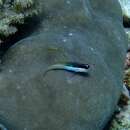Diagnostic Description
provided by Fishbase
Diagnosis. This species of the Prooculis group has the following characters: body without alternating dark and pale stripes or distinct dark spots; the head with dark postorbital stripe extending across head onto body anteriorly; in life, the dark postorbital stripe is bordered ventrally by bright white stripe; other bright markings on head white or pale yellowish; the belly is bluish (Ref. 54476).Description: This species' fins are similar to E. caeruliventris, except that an immaculate stripe-like basal area in the segmented-ray portion of the dorsal fin is not evident. It appears to be most similar to E. bimaculatus Springer, but differs mainly in lacking the two black abdominal spots and in that some individuals have a bluish abdomen. Segmented dorsal fin rays 13-14; segmented anal fin rays 15-16; caudal vertebrae 21-23; total dentary teeth 39-47 (Ref. 54476).
- Recorder
- Estelita Emily Capuli
Life Cycle
provided by Fishbase
Oviparous, distinct pairing (Ref. 205).
Biology
provided by Fishbase
Adults inhabit sheltered reefs at 3-12 m deep (Ref. 90102). Oviparous. Eggs are demersal and adhesive (Ref. 205), and are attached to the substrate via a filamentous, adhesive pad or pedestal (Ref. 94114). Larvae are planktonic, often found in shallow, coastal waters (Ref. 94114).
- Recorder
- Estelita Emily Capuli

